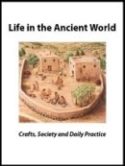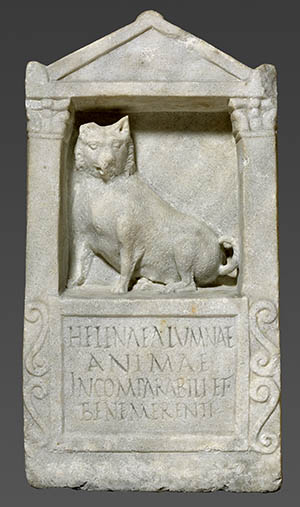How Many Times In The Bible Does An Animal Talk
What Does the Bible Say About Dogs?
Putting the Parable of the Rich Man and Lazarus in context
Megan Sauter May 24, 2022 0 Comments 50481 views
What does the Bible say about dogs? What roles did they play in the New Testament?
Justin David Strong explores dogs in the Bible and aboriginal world in his article "From Pets to Physicians: Dogs in the Biblical World," published in the May/June 2019 outcome of Biblical Archaeology Review. He shows how archaeological discoveries clarify the various roles dogs played in the Bible. In item, agreement how dogs were viewed in the Greco-Roman world illuminates the Parable of the Rich Man and Lazarus from Luke 16:19–31.
What does the Bible say most dogs?

Eurytios Krater. Dated to c. 600 B.C.E., the Eurytios Krater shows a large banquet in Hercules'south honor. Eurytios, king of Oechalia, hosts, and his daughter Iole, one of Hercules'southward love interests, attends. Dogs await beneath the table to eat the food scraps that fall to the ground. This scene helps put the Parable of the Rich Man and Lazarus (Luke 16:xix–31) in context. Alike to these dogs, Lazarus wishes to eat the scraps from the rich man's table. Photo: Jastrow/CC by ii.5.
Throughout the ancient Well-nigh Due east and Mediterranean, domesticated dogs served as companions, hunting dogs, sheep dogs, and guard dogs. Dogs filled similar roles in the Bible (e.chiliad., Chore xxx:1; Isaiah 56:10–xi). Although dogs sometimes announced in negative contexts in the Bible, such as in insults, they are non listed as ritually "unclean" animals. Stiff clarifies that at least by the second century B.C.Due east., Jews viewed dogs positively:
If the dog was always considered ritually unclean by the Israelites, it had shed this taboo past the time of the second-century B.C.E. Book of Tobit. When the writer narrates Tobias setting off on a long journey, he depicts Tobias'south pet domestic dog exiting the Jewish home to tag along on the hazard, presumably as a companion and co-guardian with the angel Raphael (Tobit half-dozen:2; eleven:4).
In the Greco-Roman world, dogs frequently sat underneath tables and ate scraps of nutrient that fell to the ground. The sixth-century B.C.E. Eurytios Krater depicts a scene with tabular array dogs. Too in the New Testament, the Syro-phoenician woman talks most table dogs: "Yeah, Lord, yet even the dogs eat the crumbs that fall from their masters' tabular array" (Matthew 15:27, NRSV).


Precious Pooch. Depicting a Maltese domestic dog, this Roman gravestone reads, "To Helena, foster kid, soul without comparing and deserving of praise." It marks the grave of a pet dog named Helena and dates to the second century C.E. Photo: Courtesy of the Getty's Open up Content Programme.
Some ancient Greeks and Romans congenital tombs or erected headstones with eloquent epitaphs for their deceased pets. These evidence that owners cherished their pets—with several inscriptions even describing the dogs as family unit members.
Dogs also filled the interesting role of physician in the Greco-Roman world. Strong explains how this developed:
Ancient authors noted, for instance, that the dog knows that information technology should elevate an injured leg, post-obit what Hippocrates prescribed. Aslope other bear witness, the ancient observer saw that the dog knows what plants to swallow as medicine to induce vomiting if it has eaten something that upsets its stomach, that the dog knows to remove foreign bodies, such as thorns, and that the dog knows to lick its wounds to ensure that they remain make clean, understanding that clean wounds heal more rapidly.
In the office of physician of the animal kingdom, dogs announced in the cult of Asclepius, the Greek god of medicine. Sacred dogs, living in the god'south temples, would lick visitors' wounds. Their tongues reputedly soothed and healed.
This understanding of dogs as physicians proves important for the Parable of the Rich Man and Lazarus in Luke sixteen:19–31. The parable reads:
There was a rich human being who was dressed in regal and fine linen and who feasted sumptuously every day. And at his gate lay a poor human named Lazarus, covered with sores, who longed to satisfy his hunger with what fell from the rich man's table; even the dogs would come and lick his sores. The poor human being died and was carried away by the angels to be with Abraham. The rich man also died and was buried. In Hades, where he was beingness tormented, he looked upward and saw Abraham far away with Lazarus past his side. He chosen out, "Father Abraham, take mercy on me, and send Lazarus to dip the tip of his finger in water and cool my natural language; for I am in desperation in these flames." But Abraham said, "Child, call back that during your lifetime you received your good things, and Lazarus in like manner evil things; just now he is comforted hither, and you are in agony. Besides all this, between you and u.s.a. a neat chasm has been fixed, so that those who might want to laissez passer from here to you cannot practice so, and no 1 can cross from there to u.s.a.." He said, "And so, father, I beg you to send him to my begetter'due south firm—for I have five brothers—that he may warn them, so that they will not also come into this place of torment." Abraham replied, "They have Moses and the prophets; they should listen to them." He said, "No, father Abraham; but if someone goes to them from the expressionless, they will repent." He said to him, "If they practice not listen to Moses and the prophets, neither volition they exist convinced even if someone rises from the dead."
(Luke 16:nineteen–31, NRSV)
In the parable, dogs lick the wounds of Lazarus. Viewing the dogs equally healers, we tin can see this was a benevolent action. Potent explains that this corrects a previous estimation of the dogs as malevolent characters: "The function of the dogs licking Lazarus has traditionally been understood by scholars to exist a point of extreme misery. Lazarus must be so disabled that he cannot drive away these 'unclean' dogs who are making a meal of him, and so the old interpretation goes. But, as we can encounter at present, this act would have been perceived by a first-century audience every bit a sign of sympathy from the dogs, who have been caring afterwards Lazarus as though his nurses."
We also run into from the parable that Lazarus wishes to eat the scraps from the rich man's table—similar a table dog. Withal, the rich man denies him even this.
Thus, the various roles of the domestic dog as companion, table dog, guard dog, sheep dog, hunter, and doctor inform our understanding of the Parable of the Rich Homo and Lazarus. To learn more than about dogs in the world of the New Testament, run into Justin David Stiff'due south article "From Pets to Physicians: Dogs in the Biblical World" published in the May/June 2019 upshot of Biblical Archaeology Review.
Subscribers: Read the full article "From Pets to Physicians: Dogs in the Biblical World" by Justin David Stiff in the May/June 2019 event of Biblical Archaeology Review.
Not a subscriber yet? Join today.
This article originally appeared in Bible History Daily in May, 2019
Related reading in Bible History Daily:
No, No, Bad Dog: Dogs in the Bible
Bible Animals: From Hyenas to Hippos
Cats in Ancient Arab republic of egypt
Did Camels Exist in Biblical Times?
The Enduring Symbolism of Doves
Become more biblical Archæology: Become a Member
The globe of the Bible is knowable. Nosotros can larn about the social club where the ancient Israelites, and later on Jesus and the Apostles, lived through the modernistic discoveries that provide us clues.
Biblical Archaeology Review is the guide on that fascinating journeying. Here is your ticket to join usa as we discover more and more almost the biblical world and its people.
Each event of Biblical Archaeology Review features lavishly illustrated and piece of cake-to-sympathise articles such as:
• Fascinating finds from the Hebrew Bible and New Testament periods
• The latest scholarship by the earth'southward greatest archaeologists and distinguished scholars
• Stunning color photographs, informative maps, and diagrams
• BAR's unique departments
• Reviews of the latest books on biblical archaeology
The BAS Digital Library includes:
• 45+ years of Biblical Archaeology Review
• 20+ years of Bible Review online, providing disquisitional interpretations of biblical texts
• viii years of Archaeology Odyssey online, exploring the aboriginal roots of the Western world in a scholarly and entertaining way,
• The New Encyclopedia of Archaeological Excavations in the Holy Country
• Video lectures from world-renowned experts.
• Access to 50+ curated Special Collections,
• 4 highly acclaimed books, published in conjunction with the Smithsonian Establishment: Aspects of Monotheism, Feminist Approaches to the Bible, The Rise of Aboriginal Israel and The Search for Jesus.
The All-Access membership pass is the way to become to know the Bible through biblical archaeology.
Source: https://www.biblicalarchaeology.org/daily/ancient-cultures/ancient-near-eastern-world/what-does-the-bible-say-about-dogs/
Posted by: velasquezancticipse.blogspot.com

0 Response to "How Many Times In The Bible Does An Animal Talk"
Post a Comment